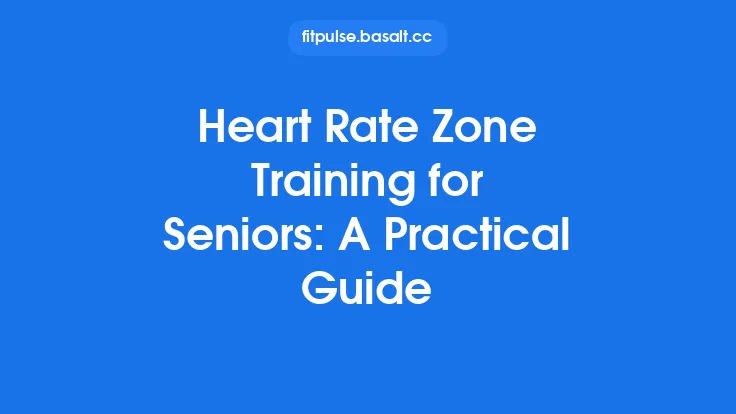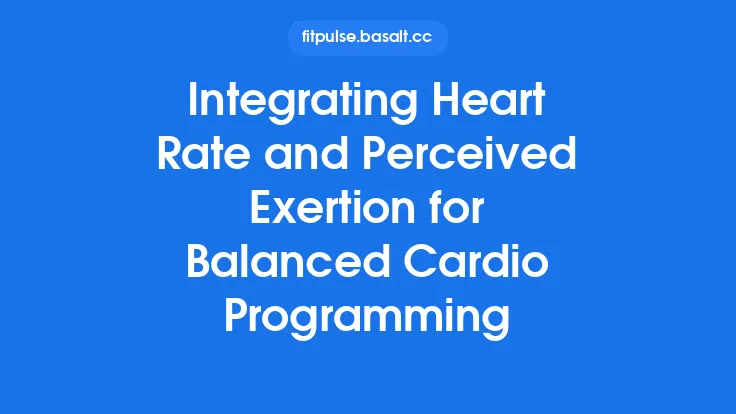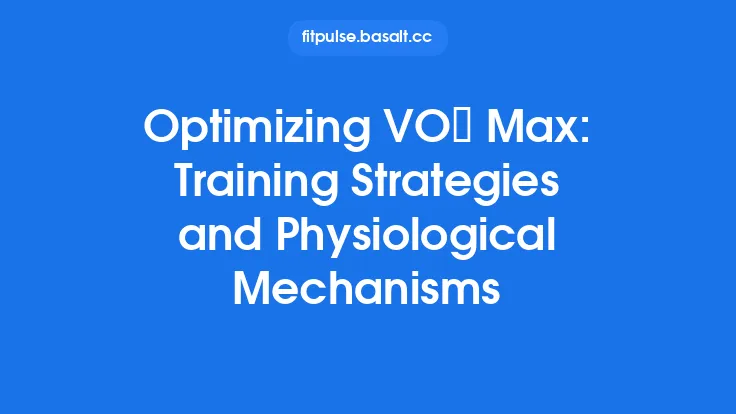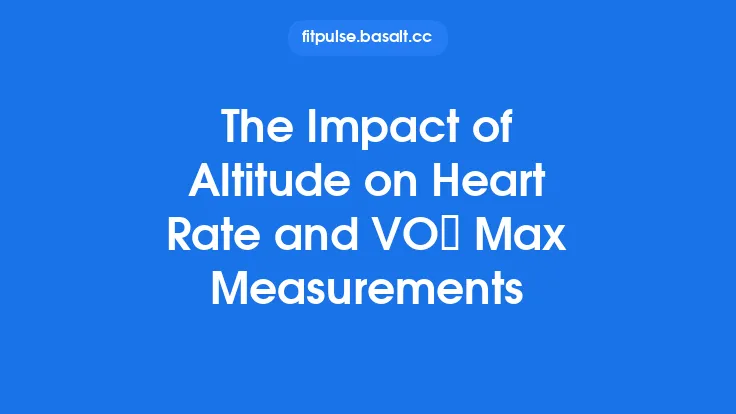Integrating heart rate (HR) and VO₂ max data creates a powerful feedback loop that lets athletes and fitness enthusiasts move beyond generic workout prescriptions toward truly personalized training plans. By understanding how these two biomarkers interact, you can fine‑tune intensity, volume, and recovery in a way that aligns with an individual’s cardiovascular capacity, metabolic efficiency, and performance goals. This article walks through the scientific foundation of HR and VO₂ max, explains how modern wearables and lab‑derived metrics can be combined, and outlines a step‑by‑step framework for building training programs that adapt as fitness evolves.
The Complementary Physiology of Heart Rate and VO₂ max
Heart Rate as a Real‑Time Indicator of Cardiovascular Stress
When you exercise, the autonomic nervous system modulates HR to meet the oxygen demand of working muscles. HR rises proportionally to the intensity of effort, reflecting the immediate load placed on the heart and circulatory system. Because HR can be measured continuously, it serves as a dynamic gauge of how hard the body is working at any given moment.
VO₂ max as a Measure of Aerobic Capacity
VO₂ max represents the maximal volume of oxygen an individual can transport and utilize per minute per kilogram of body mass (mL·kg⁻¹·min⁻¹). It is determined by the integrated efficiency of the lungs, heart, blood, and skeletal muscle mitochondria. While HR tells you how hard you are working, VO₂ max tells you how much oxygen your system can ultimately deliver and consume.
Why the Two Metrics Matter Together
- Intensity Calibration: HR alone cannot differentiate between a well‑trained athlete and a novice at the same absolute HR because the underlying VO₂ max differs. By mapping HR to a percentage of VO₂ max, you obtain a more accurate sense of relative effort.
- Efficiency Tracking: Improvements in VO₂ max often manifest as a lower HR for a given VO₂ demand, indicating enhanced cardiovascular efficiency.
- Training Load Quantification: Combining HR‑derived time‑in‑zone data with VO₂ max‑based intensity zones yields a richer picture of cumulative training stress than either metric alone.
Collecting High‑Quality Data
Lab‑Based VO₂ max Testing
The gold standard remains a graded exercise test (GXT) on a treadmill or cycle ergometer with indirect calorimetry. The test provides:
- Absolute VO₂ max (L·min⁻¹)
- Relative VO₂ max (mL·kg⁻¹·min⁻¹)
- HR at VO₂ max (HRmax)
- Submaximal HR‑VO₂ relationships (useful for creating individualized HR zones)
Wearable Heart Rate Monitoring
Modern chest straps, optical wrist sensors, and ear‑bud devices can capture HR with millisecond resolution. For integration purposes, ensure:
- Sampling Frequency: ≥ 1 Hz for most training analyses; higher rates (≥ 4 Hz) are beneficial for interval work.
- Signal Quality Checks: Use built‑in algorithms or post‑processing filters to discard artifacts caused by motion or poor skin contact.
- Synchronization: Align timestamps with any external data (e.g., power meters, GPS) to enable multi‑modal analysis.
Data Management Platforms
Cloud‑based services (e.g., TrainingPeaks, Strava, Garmin Connect) allow you to upload HR streams and VO₂ max results, then apply custom algorithms that map HR to VO₂ max‑derived intensity zones. Exportable CSV or JSON files make it easy to perform deeper statistical analyses in tools like Python or R.
Translating VO₂ max into Personalized Heart‑Rate Zones
- Determine HRmax from the VO₂ max Test
The test will reveal the HR at which VO₂ plateaus (HRmax). This value is more accurate than age‑based formulas (e.g., 220 – age).
- Establish the HR‑VO₂ Relationship
Plot HR (y‑axis) against VO₂ (x‑axis) for submaximal stages of the GXT. The slope of this line (ΔHR/ΔVO₂) reflects how much HR increases per unit of oxygen consumption.
- Define Target VO₂ Percentages
Common training intensities are expressed as percentages of VO₂ max:
- Recovery/Active Rest: 30–45 % VO₂ max
- Endurance Base: 55–70 % VO₂ max
- Tempo/Threshold: 80–90 % VO₂ max
- VO₂ max Intervals: 95–105 % VO₂ max
- Anaerobic Sprint: > 110 % VO₂ max (short bursts)
- Convert VO₂ Percentages to HR Zones
Using the HR‑VO₂ regression equation, calculate the HR that corresponds to each VO₂ target. For example, if the slope is 1.2 bpm·(mL·kg⁻¹·min⁻¹)⁻¹ and the intercept is 50 bpm, the HR for 70 % VO₂ max would be:
\[
HR = 1.2 \times (0.70 \times VO₂_{max}) + 50
\]
This yields a personalized HR zone that reflects the athlete’s true aerobic capacity.
- Validate with Field Data
Conduct a few steady‑state sessions at the calculated HR zones and compare the observed perceived exertion and lactate (if available) to the expected intensity. Small adjustments (± 3–5 bpm) are normal and help fine‑tune the zones.
Building a Training Plan Around Integrated Metrics
1. Periodization Framework
| Phase | Primary Goal | VO₂ max‑Based Intensity | HR Zone (Relative) | Typical Weekly Structure |
|---|---|---|---|---|
| Base | Aerobic foundation, capillary density | 55–70 % VO₂ max | Zone 2 (personalized) | 4–5 low‑moderate sessions, 1 long endurance day |
| Build | Raise lactate threshold, improve VO₂ max | 80–90 % VO₂ max (tempo) & 95–105 % VO₂ max (intervals) | Zone 3–4 | 2 threshold workouts, 1 VO₂ max interval, 2 easy runs |
| Peak | Maximize performance for competition | 95–110 % VO₂ max (high‑intensity intervals) | Zone 4–5 | 2–3 high‑intensity sessions, reduced volume, taper |
| Recovery | Facilitate super‑compensation | 30–45 % VO₂ max | Zone 1 | Light cross‑training, active recovery, mobility work |
Each phase uses the same HR‑VO₂ mapping, ensuring that intensity is always expressed relative to the athlete’s current aerobic capacity rather than an arbitrary heart‑rate percentage.
2. Session Design Using Dual Metrics
- Warm‑up: 10 min at 30–45 % VO₂ max (HR zone 1). This primes the cardiovascular system without inducing fatigue.
- Main Set: Choose the target VO₂ max percentage for the day’s goal. Monitor HR in real time to stay within the calculated zone. If HR drifts upward due to external factors (e.g., heat), adjust power or speed to keep VO₂ demand constant.
- Cool‑down: 5–10 min back in the recovery zone, allowing HR to descend gradually and promoting parasympathetic re‑activation.
3. Progressive Overload Through Metric Shifts
Instead of simply adding minutes or distance, progress by:
- Increasing VO₂ max Target: Move from 70 % to 75 % VO₂ max for a given session, which automatically raises the HR zone.
- Elevating HR‑VO₂ Slope: As cardiovascular efficiency improves, the same HR will correspond to a higher VO₂, indicating a higher workload without changing HR.
- Extending Time‑In‑Zone: Keep the same VO₂ max percentage but lengthen the interval duration, thereby increasing total aerobic stimulus.
Monitoring Adaptations Over Time
Key Performance Indicators (KPIs)
- VO₂ max Trend: Re‑test every 8–12 weeks. An upward shift confirms improved aerobic capacity.
- HR‑VO₂ Slope Changes: A flatter slope (smaller ΔHR per ΔVO₂) signals enhanced stroke volume and oxygen extraction.
- Time‑In‑Target Zones: Track the proportion of training minutes spent in each personalized zone. A gradual increase in high‑zone time without a rise in perceived effort suggests successful adaptation.
Data Visualization Strategies
- Scatter Plots of HR vs. VO₂: Overlay successive tests to visualize shifts in the regression line.
- Heat Maps of Weekly Zone Distribution: Quickly spot imbalances (e.g., excessive high‑zone volume) that may warrant adjustment.
- Cumulative Load Curves: Combine HR‑derived Training Impulse (TRIMP) with VO₂ max‑based intensity weighting for a holistic load metric.
Practical Tips for Seamless Integration
- Synchronize Devices – Ensure your HR monitor and any power or speed sensors share the same clock to avoid misalignment.
- Use a Dedicated Software Plugin – Many training platforms allow custom scripts; import your VO₂ max regression coefficients and let the software auto‑assign HR zones to each workout.
- Account for External Stressors – Temperature, dehydration, and altitude can temporarily shift HR at a given VO₂. When such conditions are present, rely on the VO₂‑derived intensity (e.g., power output) as the primary guide and treat HR as a secondary cue.
- Maintain a Training Log – Record subjective effort, sleep quality, and nutrition alongside HR/VO₂ data. Over time, patterns emerge that help refine the HR‑VO₂ relationship.
- Educate the Athlete – Explain why a “higher HR” does not always mean “harder work” once fitness improves. This understanding encourages adherence to the plan rather than chasing arbitrary HR numbers.
Future Directions: Toward Fully Integrated Biometric Coaching
- Machine‑Learning Models – By feeding large datasets of HR, VO₂, power, and performance outcomes into predictive algorithms, coaches can receive individualized recommendations for zone adjustments in near real‑time.
- Continuous VO₂ Estimation – Emerging wearable technologies (e.g., breath‑by‑breath sensors) aim to estimate VO₂ on the fly, allowing dynamic recalibration of HR zones during a workout.
- Closed‑Loop Training Systems – Integrated platforms could automatically modulate treadmill speed or bike resistance to keep the athlete precisely at a target %VO₂ max, using HR as a safety check.
These innovations promise to reduce the gap between laboratory precision and everyday training, making the integration of heart rate and VO₂ max an even more powerful tool for personalized fitness.
By grounding training intensity in both heart‑rate dynamics and maximal aerobic capacity, athletes gain a nuanced, data‑driven roadmap that evolves with their physiology. The process—collect accurate baseline metrics, translate VO₂ max into individualized HR zones, design periodized plans, and monitor adaptation—creates a feedback loop that continuously refines performance while minimizing guesswork. Whether you are a competitive runner, a cyclist aiming for a personal best, or a recreational athlete seeking smarter workouts, leveraging the synergy between HR and VO₂ max can transform generic training into a truly personalized journey toward optimal fitness.




